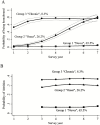Trajectories of Homebound Status in Medicare Beneficiaries Aged 65 and Older
- PMID: 30864658
- PMCID: PMC7182006
- DOI: 10.1093/geront/gnz023
Trajectories of Homebound Status in Medicare Beneficiaries Aged 65 and Older
Abstract
Background and objectives: The purpose of this study was to examine the trajectories of homebound status in older adults and to investigate the risk factors in shaping the pattern of these trajectories.
Research design and methods: The study sample was a nationally representative sample of Medicare beneficiaries aged 65 and older (N = 7,607) from the National Health and Aging Trends Study (Round 1-Round 7). Homebound state was defined as never or rarely went out the home in the last month. Homebound trajectories were identified using an enhanced group-based trajectory modeling that accounted for nonrandom attrition. Multinomial logistic regression was used to examine risk factors of homebound trajectories.
Results: Three trajectory groups were identified: the "never" group (65.5%) remained nonhomebound; the "chronic" group were largely persistently homebound (8.3%); and the "onset" group (26.2%) had a rapid increase in their risk of being homebound over the 7-year period. The following factors increased the relative risk for being on the "onset" and "chronic" versus the "never" trajectory: older age, Hispanic ethnicity, social isolation, past or current smoking, instrumental activities of daily living limitations, probable dementia, and use of a walker or wheelchair. Male sex and living alone were associated with a lower risk of being on the "chronic" trajectory, whereas depression and anxiety symptoms, chronic conditions, and activities of daily living limitations increased the risk.
Discussion and implications: The progression of homebound status among community-dwelling older adults followed three distinct trajectories over a 7-year period. Addressing social isolation and other risk factors may prevent or delay the progression to homebound state.
Keywords: Disability; Group-based trajectory modeling; Outdoor mobility.
© The Author(s) 2019. Published by Oxford University Press on behalf of The Gerontological Society of America. All rights reserved. For permissions, please e-mail: journals.permissions@oup.com.
Figures

References
-
- Brinkman S., Voortman T., Kiefte-de Jong J. C., van Rooij F. J. A., Ikram M. A., Rivadeneira F.,…Schoufour J. D (2018). The association between lifestyle and overall health, using the frailty index. Archives of Gerontology and Geriatrics, 76, 85–91. doi:10.1016/j.archger.2018.02.006 - PubMed
-
- Choi N. G., Hegel M. T., Marinucci M. L., Sirrianni L., & Bruce M. L (2012). Association between participant-identified problems and depression severity in problem-solving therapy for low-income homebound older adults. International Journal of Geriatric Psychiatry, 27, 491–499. doi:10.1002/gps.2741 - PMC - PubMed
Publication types
MeSH terms
LinkOut - more resources
Full Text Sources
Medical
Miscellaneous

